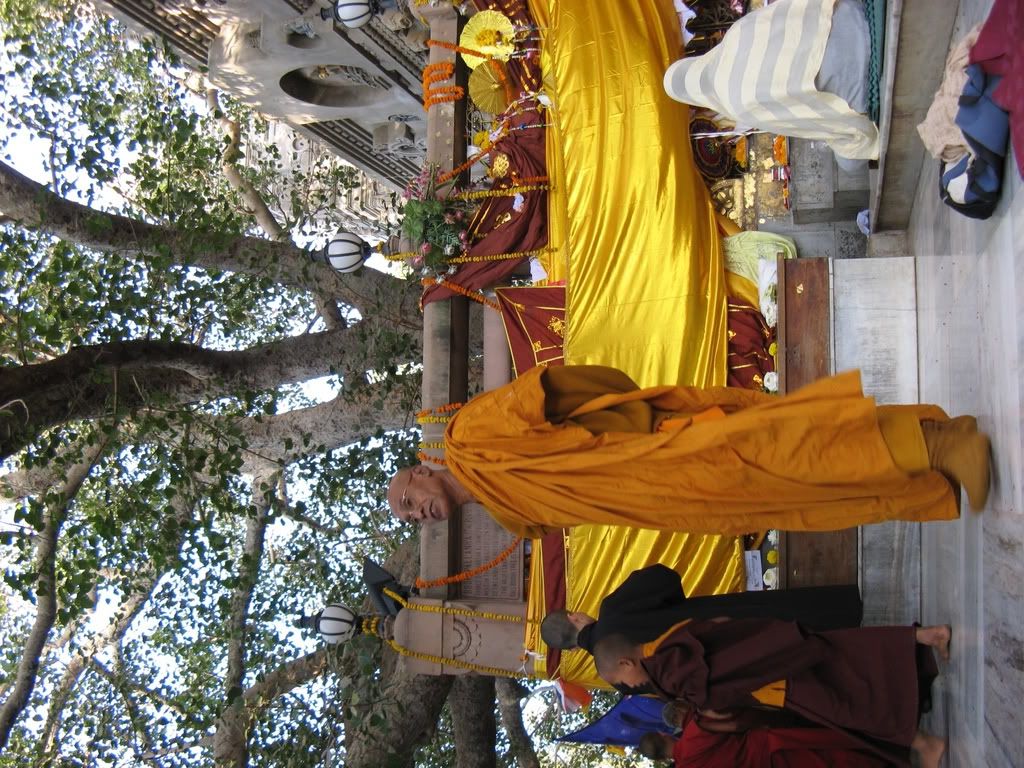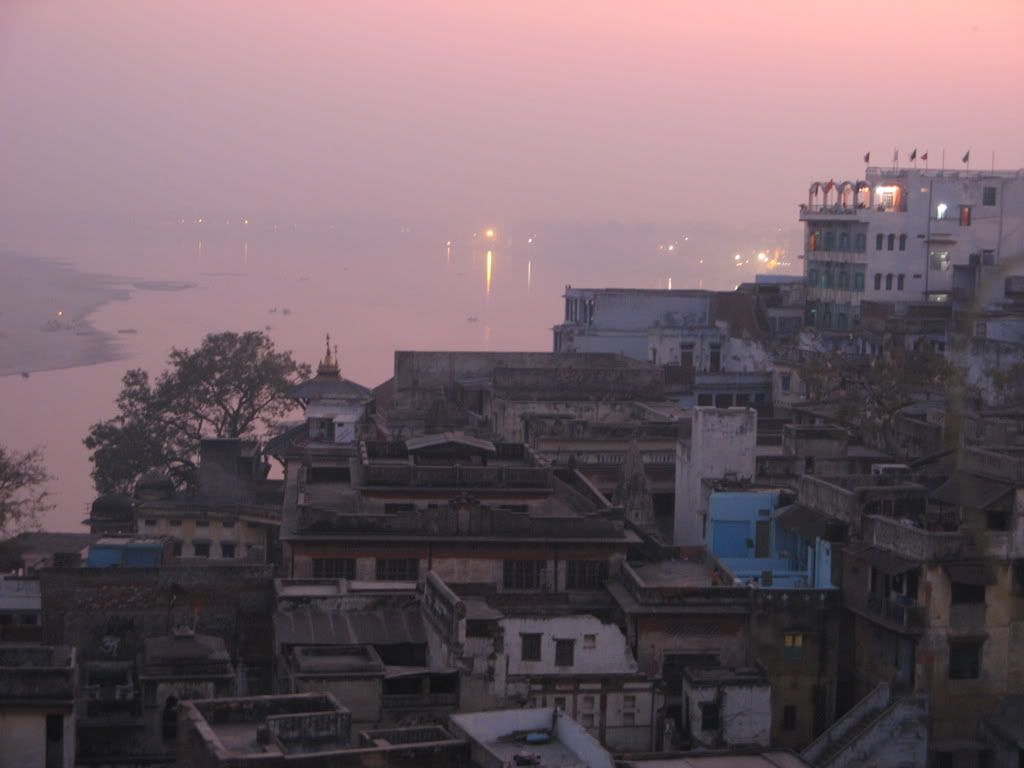Tuesday, January 29, 2008
Incommunicado
Monday, January 28, 2008
How Enlightening
- Life is suffering or dissatisfaction. The way I understand it, this means that we're tormented in big and subtle ways because our lives are never exactly how we want them to be. We have to be around things (and people) that we don't like, we we pine for things we don't have, etc.
- The cause of this suffering is craving or desire.
- There is a way out of this suffering.
- The way out is known as The Eightfold Path: right view, right intention, right speech, right action, right livelihood, right effort, right mindfulness, right concentration. This is The Buddha's prescription for the end of suffering.
I've always been curious about why I am the way I am, why I do the things I do and why I suffer. Meditation (right mindfulness and right concentration in the Eightfold Path) is what I find most helpful in that pursuit. What is meditation? I think my Zen teacher's answer to that would be sit down and see for yourself, but I'm not as wise as my Zen teacher so I'll tell you what it is for me: it is a tool for seeing. Sometimes the things we're closest to are the the things we don't really see or question. And nothing is closer than our self. Meditation for me has been a process of looking, questioning and peeling away my beliefs in order to see myself and the world with fresh eyes. I see it as a way of cultivating, peace, compassion and wonder.
We shall not cease from exploration, and the end of all our exploring will be to arrive where we started and know the place for the first time -- T. S. Eliot
Okay, that's enough philosophy.
 Bodhgaya is only a few hours away from Varanasi so I decided to visit for a few days. It turns out the train to Bodhgaya left Varanasi at 2:00 in the morning. Towns and cities in India (and Nepal for that matter) roll up the streets pretty early, so I wasn't thrilled about making my way through the dark, abandoned alleys of the old city to find a ride to the train station so late at night. To my relief, it turns out a guy named Mat was heading the same way--we had had a couple of adventures together in Varanasi and I really enjoyed his company. He's a journalist from New Zealand and is writing a book about his experiences as a recovering alcoholic traveling the world visiting different Alcoholic Anonymous meetings. Around the World in 80 AA's, he's calling it.
Bodhgaya is only a few hours away from Varanasi so I decided to visit for a few days. It turns out the train to Bodhgaya left Varanasi at 2:00 in the morning. Towns and cities in India (and Nepal for that matter) roll up the streets pretty early, so I wasn't thrilled about making my way through the dark, abandoned alleys of the old city to find a ride to the train station so late at night. To my relief, it turns out a guy named Mat was heading the same way--we had had a couple of adventures together in Varanasi and I really enjoyed his company. He's a journalist from New Zealand and is writing a book about his experiences as a recovering alcoholic traveling the world visiting different Alcoholic Anonymous meetings. Around the World in 80 AA's, he's calling it.At about midnight, we made our way out of the old city to a main street hoping to get a bicycle or auto-rickshaw to the train station. I was immediately glad he was with me. The place looked like some kind of post-apocalyptic vision. There were small fires at every other corner with wraith-like Indians huddled around them. Others were stumbling around in a daze. Someone came up behind us and asked us if we needed a ride somewhere. He looked harmless enough, but the bicycle rickshaw driver he roused certainly didn't. I don't know if he was still half asleep or on something but I was happy it was a bicycle and nothing that could go more than a few miles an hour. After haggling for a fair price, we slung our packs onto the rickshaw and headed to the station. Even though the rickshaw was completely open, it gave me enough psychological distance from the otherworldly Varanasi night that I was enjoying that exhilarating sweet spot that lies between uncertainty and fear.
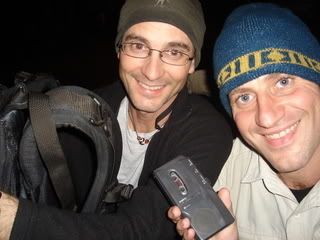 und and hands us a screeching micro cassette player. "Music," he said. Mat took it in his hand; we looked at each other and busted up laughing. You just never know what's going to happen in India, you really don't. The tape would speed up and slow down or just stop until we gave it a good whack. It was painful to listen to, but when we learned it was music from his wedding we decided to keep it on till we arrived. Mat snapped a quick picture.
und and hands us a screeching micro cassette player. "Music," he said. Mat took it in his hand; we looked at each other and busted up laughing. You just never know what's going to happen in India, you really don't. The tape would speed up and slow down or just stop until we gave it a good whack. It was painful to listen to, but when we learned it was music from his wedding we decided to keep it on till we arrived. Mat snapped a quick picture.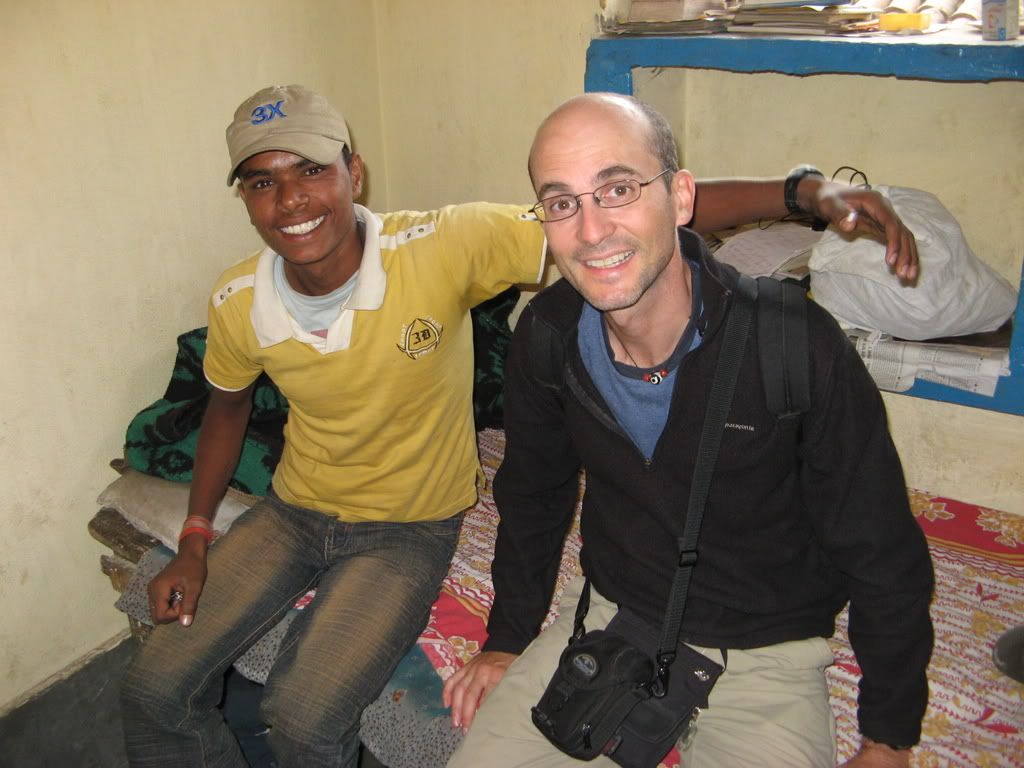 At this point it was so obviously choreographed that I was almost laughing. Less than ten minutes after we arrived a big plate of dahl and rice appeared.
At this point it was so obviously choreographed that I was almost laughing. Less than ten minutes after we arrived a big plate of dahl and rice appeared. Shortly after that, Rohit's "uncle" came into the room. He also worked at the orphanage that was so casually mentioned earlier. And finally an incredibly cute little boy and his English book found his way into the room. He is, of course, one of the orphans.
Shortly after that, Rohit's "uncle" came into the room. He also worked at the orphanage that was so casually mentioned earlier. And finally an incredibly cute little boy and his English book found his way into the room. He is, of course, one of the orphans.It's hard to tell from the picture above, but there's something of a high fence that separates the gardens (where the monks are) from a wide walkway around the base of the temple. The fence made it possible to visit the Bodhi tree, even though it was the focal point of this huge gathering.
The picture above was taken in the walkway I mentioned. The tree behind the fence is the Bodhi tree. As luck would have it, there was space for me to sit on a ledge along the fence. This picture was taken my vantage point. There were a few monks sitting next to me and they made me feel right at home. Some of the young monks would come around with big kettles of chai and those around me made sure I got a cup. I can't tell you what a wonderful experience this was. Just behind me hundreds of monks were chanting in Tibetan (beautifully, I might add) while I was sitting about 50 feet from the place of the Buddha's enlightenment. It was quite powerful.
In the picture above, you can see the actual spot under the Bodhi tree where the Buddha attained enlightenment, marked by the "Diamond Throne."
A couple more Bodhgaya pictures:
I ended up staying in Bodhgaya for a few days, immersed in the mystique of the place. I left on Christmas Eve. That was the day of that trying 17 hour train ride I mentioned in a past post. Next stop: Agra, home of the Taj Mahal.
Sunday, January 6, 2008
Varanasi
I can't say I've been anywhere in the world that is even remotely like it. One of the oldest continually inhabited cities in the world, people have been living here for possibly longer than five thousand years. It lies on the west bank of the river, Ganges, and is one of India's holiest places as well as an important pilgrimage site. The Ganges is considered sacred, an incarnation of the goddess, Ganga. People come here to bathe in the river, which, according to Hindu belief, washes away their sins. It is also understood that dying here will ensure an end to reincarnation, the cycle of rebirth (in case you're wondering, this is considered a very good thing).



Or wash those sins away. Now, I have to point out--I guess I don't really have to point it out, but I'm going to--that the Ganges here in Varanasi is incredibly polluted. From the Lonely Planet:
Every day about 60,000 people go down to the Varanasi ghats to take a holy dip along a 7km stretch of the river. Along this same area, 30 large sewers are continually discharging into the river...Samples from the river show the water has 1.5 million faecal coliform bacteria per 100ml of water. In water that is safe for bathing this figure should be less than 500!
Knowing this, I would cringe every time I would watch scenes like this:

But the most surreal thing about Varanasi is the burning ghat, where literally hundreds of bodies a day are cremated around the clock. Unlike our cremations, these (at least at this ghat) are done out in the open on wood pyres. There are usually around ten or so going at one time, on different platforms, at different heights. Where you're burned and what kind of wood is used (Sandalwood is most expensive) depends a number of things, including your caste and how much cash you have stashed away. Here's a photo of the largest burning ghat, Manikarnika, which just happened to be very close to my hotel (I could sometimes smell the smoke as I was drifting off to sleep...mmm). You can walk right up to the area where the bodies are burning, but this was about as close as I could get to take a photo without being culturally insensitive (and risk having my camera thrown in the river).
Coming from a culture where death is so often hidden away, I found it extremely fascinating to watch. As you might imagine, there's quite a ritual that goes along with the cremation, one that I never did figure out entirely (I also got conflicting accounts from various people, including Indians) but, with that disclaimer, this is what I remember: The bodies are wrapped in bright multi-colored cloth and placed on a bamboo stretcher that is carried by family members through the town to the ghat. They chant "Ram nam sach hai! Ram nam sach hai!"-- The name of God is truth! After dipping the body in the Ganges, the eldest son--whose head has been shaved except for one small tuft of hair--lights the fire. There are people whose job is to burn the bodies, members of a low caste. They watch over the cremation, which usually takes a few hours. Afterward the pelvic bone if it's a woman or the ribcage if it's a man are deposited into the Ganges--for some reason these bones don't burn completely. I didn't notice any weeping, or emotion of any kind, for that matter; but only men are allowed to attend because women can be "too emotional." It all seemed so efficient and matter-of-fact which only made the whole thing more surreal. The air is thick with smoke but, thankfully, only smells like a pleasant campfire. Most of the pyres just look like piles of burning wood, but on a few of them, the human form is easily recognizable. I didn't find it disgusting or repulsive, even when one of the attendants started moving a body around to get it burning better. It was just so intensely interesting (I don't know what that says about me). But that's one of the things I love about travel, you see things that are so out of your normal range of experience that, for me at least, my brain shuts down its continual commentary and I just get the unadulterated sensory experience. I love those moments.
The area around the burning ghat is busy with business of burning: head shaving, people weighing wood, the selling cloth and other burning paraphernalia. Have you ever been to the ruins of an ancient place and wished you could go back in time to see what it actually looked like when it was inhabited all those years ago? Along with the flaming bodies, I think that is what I found so intriguing about the burning ghat. The place and the ritual is ancient so there was a real sense of having gone back in time--minus all the signs for the Internet, of course.
As you move away from the river and into Varanasi, the old town is a maze of alleyways that, in most places, aren't more than ten feet wide. Walking these narrow lanes was one of my favorite ways to spend the day. They are filled with bicycles, motorcycles, people, and unattended animals of all kinds, from goats to huge water buffaloes. Those funeral processions were always going by, too--I was always afraid I was going to accidentally trip one of the stretcher bearers, sending somebody's recently passed relative tumbling down the street. There are temples and shops (silk is big here) and alley-side vendors selling everything from from food to incense to paan, a popular I-don't-know-what-to-call-it of various ingredients wrapped in a betel leaf. It is chewed, producing bright red saliva which is then spit out (usually to the place you're just about to step). Because of the narrowness and many stair cases most motor traffic (some motorcycles still speed through) is eliminated which made for a much more peaceful experience than most of what I've seen so far in India.
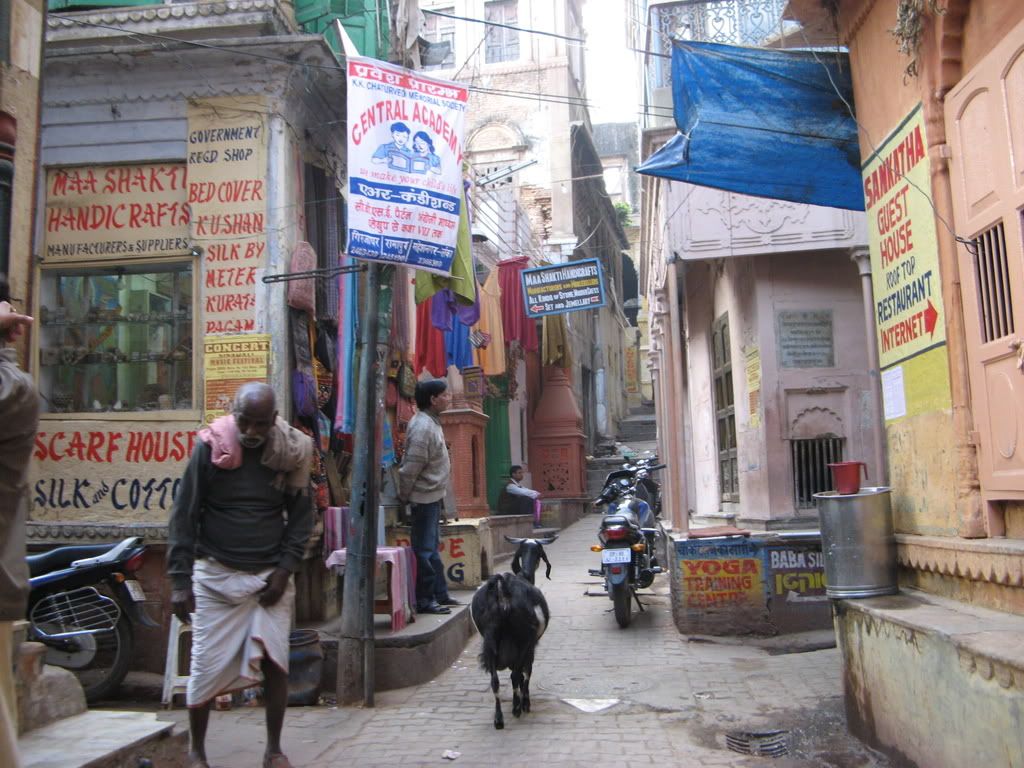
It was a wonderful blend of colors, smells, sounds and faces and I'd walk for hours at a time.

Fortunately, no matter how lost you get, you eventually end up back at the ghats where, hopefully, you've memorized a route back to your hotel.
One night while I was out strolling, a yogi approached me on one of the ghats and asked me to come check out his "studio" to see if I would like to study yoga with him. I was hesitant, but had been wanting to try out some yoga in its birthplace. He finally talked me into it--I think mostly because he just looked the part. His studio turned out to be his one room "apartment." I really didn't want to do a session that night but after some more cajoling I agreed to a two hour lesson of "real yoga," not that "exercise you get in States." We went up to the roof of his building where it was a beautiful, warm evening bathed in the setting sun's last rays. I was just tickled at the whole scene. The two of us sitting crossed legged on a big blanket, his grey beard, long beaded hair and robes. The session started off with the philosophy behind yoga and this came mostly in the form of a questions about what I thought yoga was, who I thought God is, what is concentration, what is meditation, and a number of other things. I tend to think a lot on these kinds of things and the meanings have become slippery to me, so my answers were filled with maybes and not-sures. This coupled with the fact that it took so long for me to make up my mind about doing the session in the first place was getting him slightly exasperated. To him, this was all a sign of how much training I needed. Your meditation is "primary school," he said. It was all said in a good-natured way and I took no offence. I remember at one point he asked me how my wife dealt with me and my indecisiveness. "I'm not married," I said. "Girlfriend?" "No, I don't have one of those either." He shook his head in a way that said, yup, no surprise there. We finally did get around to some meditation and yoga. It was nice, but really didn't impress me. We ended with a short walk around the town and a cup of chai. He tried to get me to commit to another session the next morning but I couldn't decide if I was up for it or not.

Okay, one more story: One morning as I was on my way up to the restaurant at the hotel, I ran into a couple hastily making their way down the stairs, toast in hand. "I wouldn't go up there," they said, "there's a monkey on the loose." I, of course, immediately picked up the pace. I had been seeing monkeys around the restaurant since I arrived (sometimes they'd jump on the roof, mischievous little devils), but this was the first one that had come inside. As I reached the last flight of stairs, I could hear shouts and other sounds of commotion. There was a Dutch guy, Florin, that I knew, backing his way down the steps with a broom held out in front of him. He was visibly shaken and told me the same thing: monkey on the loose. "He's eating people's breakfast and drinking tea!" Now this I had to see. We made our way up the stairs, Florin still holding the broom out in front of him. As I got a view into the restaurant, I could see people cowering behind tables and the staff hiding behind the door to the kitchen. Sure enough, there was a monkey sitting on one of the tables, looking aggressive and baring his teeth. When he caught our eyes, he launched himself towards us! We spun around and bolted down to the next floor. Looking over my shoulder I saw the monkey scurry past us and down the next flight of stairs. Worried he would come back, we frantically started trying all the doors on the floor, looking for a place to hide. He didn't, but what fun.



